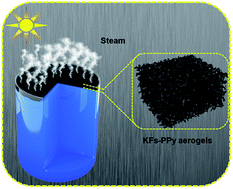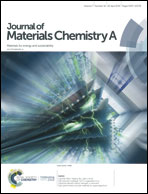Conductive hollow kapok fiber-PPy monolithic aerogels with excellent mechanical robustness for efficient solar steam generation†
Abstract
Solar steam generation by heat localization has attracted much attention for its potential in the treatment of wastewater and seawater desalination. However, the preparation of a single-component solar receiver with low cost, simple preparation process, high mechanical strength and energy conversion efficiency is still a challenge. Herein, we report the preparation of kapok fiber-PPy aerogels with superwetting, porous structure, high light absorption, and high mechanical strength via polypyrrole modification of the Ca2+ crosslinked kapok fiber aerogels. The kapok fiber-PPy aerogels show three-dimensional structure with high porosity (94%), excellent light absorption (ca. 97%), low thermal conductivity (0.0241 W m−1 k−1) and high mechanical strength (0.12 MPa under 75% of strain). As a solar steam generation device, a high energy conversion efficiency of 82.4% was achieved under 1 kW m−2 illumination. The findings of this investigation may open a simple and novel route towards the fabrication of a low-cost a single-component biomass-based solar receivers for solar steam generation.

- This article is part of the themed collection: 2019 Journal of Materials Chemistry A Most Popular Articles


 Please wait while we load your content...
Please wait while we load your content...